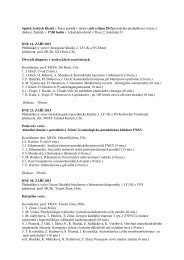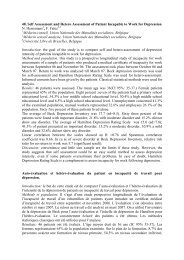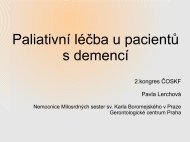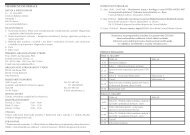ABSTRACTS â ORAL PRESENTATIONS - AMCA, spol. s r.o.
ABSTRACTS â ORAL PRESENTATIONS - AMCA, spol. s r.o.
ABSTRACTS â ORAL PRESENTATIONS - AMCA, spol. s r.o.
You also want an ePaper? Increase the reach of your titles
YUMPU automatically turns print PDFs into web optimized ePapers that Google loves.
ability to intercalate DNA although they possessed various affinity to DNA (in vitro<br />
studies). Furthermore, hexyl-AcrDIM, the derivative with weak DNA-binding affinity, had<br />
the most potent cytotoxic effect against several cancer cell lines.<br />
In our present study, we have analyzed the accumulation and distribution of AcrDIMs in<br />
mouse leukemic cell line L1210 to explain different cytotoxicity of analogs in the series.<br />
We have monitored intracellular distribution of propyl- and hexyl-AcrDIM using an Amnis<br />
ImageStream Imaging Flow Cytometer. Surprisingly, the colocalizations of AcrDIMs with<br />
nucleic acids stain SytoRed 62 have shown that studied derivatives were not accumulated<br />
in the nucleus even after long-term incubation (24 h). They were not localized in the<br />
lysosomes as well (colocalization study of the derivatives with Monodansylcadaverine).<br />
The fluorescence of propyl-AcrDIM was not overlaid with mitochondrial dye MitoRed,<br />
but the derivative with the highest lipophilicity - hexyl-AcrDIM was partially accumulated<br />
in the mitochondria (24 h).<br />
Our results have confirmed that hexyl-AcrDIM, the most cytotoxic derivative of series,<br />
was partially accumulated in the mitochondria. Mitochondrion, the energetic center of<br />
cell and a key organelle in an intrinsic apoptotic pathway, is target of many anticancer<br />
agents (Costantini et al., 2000). They may cause mitochondrial dysfunction and induce<br />
oxidative stress in the cells. The level of superoxide radical in the cells treated with<br />
hexyl-AcrDIM has increased several times, and block in synthetic phase of cell cycle<br />
and apoptotic DNA-fragmentation has occurred. Nevertheless, cytotoxic mechanism of<br />
hexyl-AcrDIM is not clear, yet. But the lipophilicity plays a crucial role in the distribution<br />
of AcrDIMs and their following anticancer effect.<br />
Acknowledgments<br />
This work was supported by Structural Funds EU (ITMS: 26240220071) and the Grant<br />
Agency VEGA of the Ministry of Education of the Slovak Republic (1/0672/11, 2/0177/11)<br />
and it is result of the project implementation: TRANSMED 2, ITMS: 26240120030,<br />
supported by the Research & Development Operational Programme funded by the ERDF.<br />
References<br />
Costantini, P., Jacotot, E., Decaudin, D., Kroemer, G.: Mitochondrion as a novel target<br />
of anticancer chemotherapy. - Journal of the National Cancer Institute 92: 1042-1053,<br />
2000.<br />
Cholewinski, G., Dzierzbicka, K., Kolodziejcyk, A.M.: Natural and synthetic acridines/<br />
acridones as antitumor agents: their biological activities and methods of synthesis. -<br />
Pharmacological Reports 63: 305-336, 2011.<br />
Janovec, L., Kožurková, M., Sabolová, D., Ungvarský, J., Paulíková, H., Plšíková, J., Vantová,<br />
Z., Imrich, J.: Cytotoxic 3,6-bis((imidazolidinone)imino)acridines: synthesis, DNA binding<br />
and molecular modeling. - Bioorganic & Medicinal Chemistry 19: 1790-1801, 2011.<br />
Peixoto, P., Zeghida, W., Carrez, D., Wu, T.D., Wattez, N., Croisy, A. Demeunynck, M.,<br />
Guerquin-Kern, J.L., Lansiaux, A.: Unusual cellular uptake of cytotoxic 4-hydroxymethyl-<br />
3-aminoacridine. - European Journal of Medicinal Chemistry 44: 4758-4763, 2009.<br />
Analytical Cytometry VII 183








